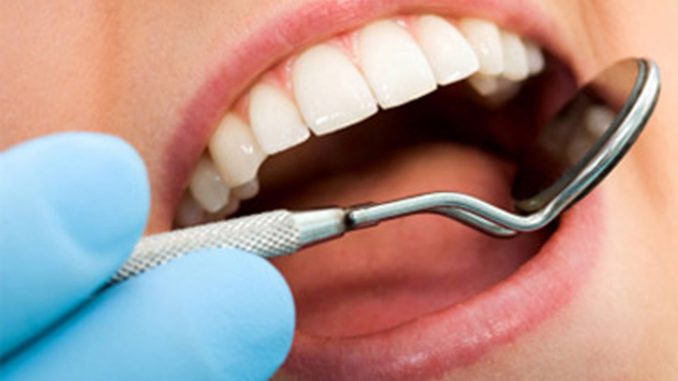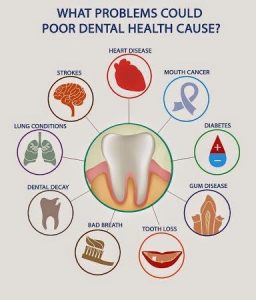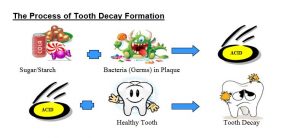
Table of Contents
What is oral health?
- Oral health, also considered as Dental health includes the capability to speak, smile, smell, taste, touch, chew, swallow, and deliver facial expressions with confidence and excluding pain, discomfort, and disease of the craniofacial complex.
- Oral health is an important aspect of health, physical and mental well-being.
- However, according to the Global Burden of Disease Study 2016 half of the world’s population (3.58 billion people) are estimated to be affected by oral diseases.
What are the different oral health problems?
Oral health problems are classified into common and uncommon health problems. These problems are:
| S.N. | Common Oral diseases | Uncommon Oral diseases |
| 1. | Dental caries(tooth decay) | Oral herpes |
| 2. | Periodontal/ gum disease | Dry mouth |
| 3. | Oral cancers | Burning Mouth Syndrome |
| 4. | Oral manifestation of HIV | Thrush |
| 5. | Oro-dental trauma | Temporomandibular Joint Pain |
| 6. | Cleft lip and palate | |
| 7. | Noma among the children under the age of 6 due to malnutrition. |
Why is dental health care important?
- Dental health care plays a large role in maintaining our bodily functions. The main objective of dental health care is to prevent cavities, gum disease and keep mouth free from germs.
- Better dental health also prevents from various diseases like heart disease, strokes, diabetes, respiratory issues etc., as it prevents bacterial infection and inflammation of blood vessels.
- To provide confident visual appearance.

What are dental caries?
- Dental caries, simply a term for tooth decay or cavities caused due to microbial infections or multiple factors that deteriorates the tooth’s enamel and gums.
- Global Burden of Disease Study 2016 revealed that dental caries (tooth decay) in permanent teeth is the most prevalent condition among world population.
How does it (dental caries) happen?
There are numerous theories for dental caries or cavities. Some of them are:
-
Acidogenic theory (Millers chemico-parasitic theory)
- This theory is widely accepted and it states that dental decay occurs through chemico-parasitic process with the involvement of two stages:
Stage 1: Decalcification of enamel, which leads in its total destruction
Stage 2: Decalcification of dentine with dissolution of the softened residue.
-
- Acid affecting dissolution comes from fermentation of starch and sugar blocked in the holding centers of the teeth.
-
Proteolytic theory
- This theory claims that lytic enzymes are responsible for dental caries when they attack the organic portion of the tooth.
-
Proteolysis-chelation theory (Schatz’s theory)
- This theory claims that breakdown of organic components i.e. keratin specifically due to microbial attack by keratinolytic microorganisms that results in decalcification of enamel at a neutral point is the reason for dental caries.
- The above theories somehow explained the process of dental caries in a human body but unable to explain all the consequences of the disease. Despite of the failure, all three theories agreed on the following major reasons for dental caries:
- Host
- Flora
- Substrate

Clinical classification of dental caries
Dental caries are classified on the following basis:
-
Based on the location of single tooth:
– Pit and fissure carries
– Smooth surface carries
– Root caries/Senile carries
-
Based on the promptness of the process:
– Acute/ Rampant carries
– Chronic caries
-
Based on the new lesion attacking earlier unharmed surface or the lesion is arising around the margins of a repaired surface.
– Primary caries
– Secondary/Recurrent caries.
-
Based on the pathway of dental caries
– Forward caries
– Backward caries
-
Based on the involvement of the tooth surfaces
– Simple caries
– Compound caries
– Complex caries
Major causes of dental health problems
According to the Institute of Medical Science & Research Centre, the major causes of dental problems are:
Insufficient Ptyalin:
Ptyalin is responsible for the breakdown of starch into sugar with the help of tooth preserving systems in our body. Hence, the broken down starch gets dissolved in the saliva and washed away but lack of tooth preventing systems, the starch gets locked in around the teeth and the harmful bacteria feeds on the trapped starch , releasing acids that destroy enamel and leads to tooth decay.
Saliva’s alkalinity:
The alkaline buffers produce in the saliva works as the next line of protection to neutralize the enamel troubling acids formed on the teeth.Salivas alkaline components are composed of calcium, magnesium, potassium and sodium and in lack of or short supply of the components hinders the saliva’s buffering capacity and tooth decay occurs in a meteoric phase.
Insufficient Saliva:
When the production of saliva itself is insufficient in the body, which could be the reasons such as diets that are poor in consumption of fruits, vegetables and liquids, and high on cereals; inadequate vitamin A or low thyroid levels cause a dry mouth i.e. insufficient saliva and accumulation of harmful bacteria resulting tooth decay.
Food habits:
Starchy, refined carbohydrates foods are harmful to the teeth as candy. Similarly carbonated beverages and high intake of sugary items results in poor oral health.
Precautions for better oral/dental hygiene:
The advance tips for good oral/dental hygiene are as follows:
- Staying hydrated in order to prevent dry mouth so that the harmful bacteria are washed away.
- Avoiding carbonated drinks and sugary items.
- Visiting dentist for cleaning and checkup for at least one or two times a year.
- Replacement of normal toothbrush with interdental brushes every three to four months.
- Brushing teeth twice a day in order to prevent bad breath and removal of bacteria.
- Use of floss and tongue cleaner
Measures for better dental hygiene
The measures for better dental hygiene would be
- Existing oral hygiene measures used in respect with regular professional care.
- Use of inter-dental brushes and wooden sticks.
- Chewing sugar free gums as a salivary stimulant.
- Active role-play by the parents, school and the media for children, workplace, and social environments regarding dental hygiene.
- Mechanical and chemotherapeutic approaches to oral hygiene that target to transform the oral micorflora resulting in upliftment of health periodontal and dental tissues.
- Reducing smoking and tobacco use.
- Consumption of low sugar foods.
- Intake of more fruits and vegetables as it may have a protective role against harmful microorganisms
References and For More Information:
https://www.colgate.com/en-us/oral-health/conditions/cavities/dental-caries-cavities
https://www.slideshare.net/PARTHPMT/dental-caries-11404622
https://en.wikipedia.org/wiki/Dentistry
https://jada.ada.org/article/S0002-8177(14)00029-4/fulltext
https://www.ncbi.nlm.nih.gov/pubmed/11695154
https://www.who.int/news-room/fact-sheets/detail/oral-health
https://www.who.int/oral_health/publications/sugars-dental-caries-keyfacts/en/
1.Entwistle BA. Oral health promotion for the older adult: implications for dental and dental hygiene practitioners. Journal of dental education. 1992;56(9):636-9.
2.Choo A, Delac DM, Messer LB. Oral hygiene measures and promotion: review and considerations. Australian dental journal. 2001;46(3):166-73.